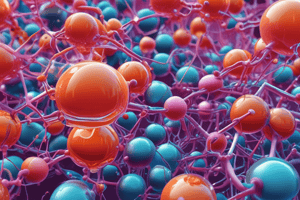Podcast
Questions and Answers
Which reaction involves two alkyl halides coupling in the presence of sodium metal?
Which reaction involves two alkyl halides coupling in the presence of sodium metal?
- Clemmenson reduction
- Wurtz reaction (correct)
- Catalytic hydrogenation
- Decarboxylation
What type of addition occurs during catalytic hydrogenation of alkenes and alkynes?
What type of addition occurs during catalytic hydrogenation of alkenes and alkynes?
- Anti-addition
- Stereospecific addition
- Non-specific addition
- Syn-addition (correct)
What is the primary product of the combustion of alkanes?
What is the primary product of the combustion of alkanes?
- Carbon dioxide and water (correct)
- Carbon monoxide and hydrogen
- Alkenes and acetylene
- Carboxylic acids
Which of the following statements about alkanes is true?
Which of the following statements about alkanes is true?
In the halogenation of methane, what role does ultraviolet light play?
In the halogenation of methane, what role does ultraviolet light play?
What is the primary cause of the instability in the eclipsed conformation of ethane?
What is the primary cause of the instability in the eclipsed conformation of ethane?
Which conformation of cyclohexane is considered the most stable?
Which conformation of cyclohexane is considered the most stable?
During conformational analysis, which type of strain occurs when the angle between adjacent bonds deviates from the ideal value in a molecule?
During conformational analysis, which type of strain occurs when the angle between adjacent bonds deviates from the ideal value in a molecule?
How many staggered conformations does butane possess between its two middle carbons?
How many staggered conformations does butane possess between its two middle carbons?
Which of the following statements about cyclohexane is true?
Which of the following statements about cyclohexane is true?
Flashcards
Conformational Isomerism
Conformational Isomerism
Different arrangements of atoms in a molecule that arise from rotation around single bonds. They can quickly interconvert at room temperature.
Newman Projection
Newman Projection
A way to visualize the conformation of a molecule by looking down a specific carbon-carbon bond.
Staggered Conformation
Staggered Conformation
The most stable conformation of ethane where the hydrogen atoms on adjacent carbons are as far apart as possible.
Eclipsed Conformation
Eclipsed Conformation
Signup and view all the flashcards
Chair Conformation
Chair Conformation
Signup and view all the flashcards
Cyclohexane Axial & Equatorial Bonds
Cyclohexane Axial & Equatorial Bonds
Signup and view all the flashcards
Clemmenson Reduction
Clemmenson Reduction
Signup and view all the flashcards
Catalytic Hydrogenation
Catalytic Hydrogenation
Signup and view all the flashcards
Wurtz Reaction
Wurtz Reaction
Signup and view all the flashcards
Alkane Halogenation
Alkane Halogenation
Signup and view all the flashcards
Study Notes
Pharmaceutical Organic Chemistry-1 (PC102) Lecture 5
- Conformational Isomerism: Produced by rotation around single bonds, often rapidly interconverting at room temperature. Also known as conformers, rotamers, or rotational isomers.
- Conformational Analysis: The study of energy changes due to this free rotation.
- Newman Projection: The best way to represent conformations.
Conformational Analysis of Ethane
- Staggered Conformation: Each C-H bond of one carbon bisects the H-C-H angle of the other carbon.
- Eclipsed Conformation: Each C-H bond of one carbon is aligned with a C-H bond of the other carbon.
Conformational Analysis of Butane
- Staggered Conformers (Butane): Butane has two different staggered conformations: Gauche and anti.
- Types of Strain:
- Eclipsed: Torsional strain and steric strain (Van der Waals strain).
- Gauche: Steric strain.
- Anti: No strain—most stable.
Conformation of Cycloalkanes with Small Rings
- Cyclopropane: Contains three carbon atoms; planar; C-C-C bond angle is only 60°, much less than the typical tetrahedral angle of 109.5°; hydrogen atoms lie above and below the carbon plane, and hydrogens on adjacent carbons are eclipsed. Exhibits angle strain and torsional strain.
- Cyclobutane: Can reduce torsional strain by adopting a nonplanar "puckered" conformation, decreasing eclipsing interactions. It adopts an envelope shape.
- Cyclopentane: Acquires an envelope shape.
Conformation of Cyclohexane
- Chair Conformation: The most stable conformation for cyclohexane; nonplanar; C-C-C bond angle is 111° with no torsional and no angle strain.
- Boat Conformation: Less stable than the chair; no angle strain, but it has eclipsing strain from pairs of hydrogen atoms on carbons 1-4, 2-3, and 5-6.
- Twist-Boat Conformation: More stable than the boat.
- Half-chair Conformation: The least stable; exhibits both angle and eclipsing strain.
Axial and Equatorial Bonds of Cyclohexane
- Axial Bonds: Bonds parallel to the vertical axis (up and down on adjacent carbons).
- Equatorial Bonds: Bonds arranged along the equator of the molecule.
Synthesis of Alkanes
- Clemmenson Reduction: Reduces carbonyl compounds to alkanes using Zinc amalgam (Zn/Hg) and HCl.
- Catalytic Hydrogenation: Adds hydrogen to alkenes and alkynes, often producing a syn addition. Requires a transition metal catalyst (e.g., platinum, palladium, or nickel) under specific temperature and pressure conditions.
Reactions of Alkanes and Cycloalkanes
- Combustion: Alkanes react with oxygen to form carbon dioxide and water.
- Halogenation: Substitution of hydrogen atoms in alkanes with halogen atoms (e.g., chlorine, bromine), often a free radical substitution reaction initiated by ultraviolet light or high temperatures. Bromination is selective, favoring tertiary > secondary > primary hydrogens.
- Reaction between methane and chlorine: A photochemical chain reaction.
Multiple Substitutions in Methane/ Chlorine Reaction
- Multiple substitution of chlorine in methane can occur to form chloromethane, dichloromethane, trichloromethane, or tetrachloromethane .
Additional Information
- Regioselectivity: Bromination of alkanes occurs preferentially at tertiary then secondary then primary hydrogen.
Studying That Suits You
Use AI to generate personalized quizzes and flashcards to suit your learning preferences.




